Professional Skills in the Digital Age: A Social Media Analysis
VerifiedAdded on 2023/01/16
|9
|2688
|73
Report
AI Summary
This report examines the pervasive influence of social media on professional skills in the digital age, highlighting both the positive and negative aspects of these platforms. It discusses the connectivity and information-sharing benefits, as well as the risks of cyberbullying and mental health impacts. The report also addresses critical security and privacy challenges, such as hacked accounts and phishing attacks, and suggests measures like using unique passwords and avoiding oversharing personal information. Furthermore, it explores the features and applications of popular social media platforms like Facebook and Instagram, assessing their suitability for business use in terms of customer engagement, brand visibility, and overall marketing effectiveness. The conclusion emphasizes social media's continued importance as a communication tool and its impact on organizational strategies.
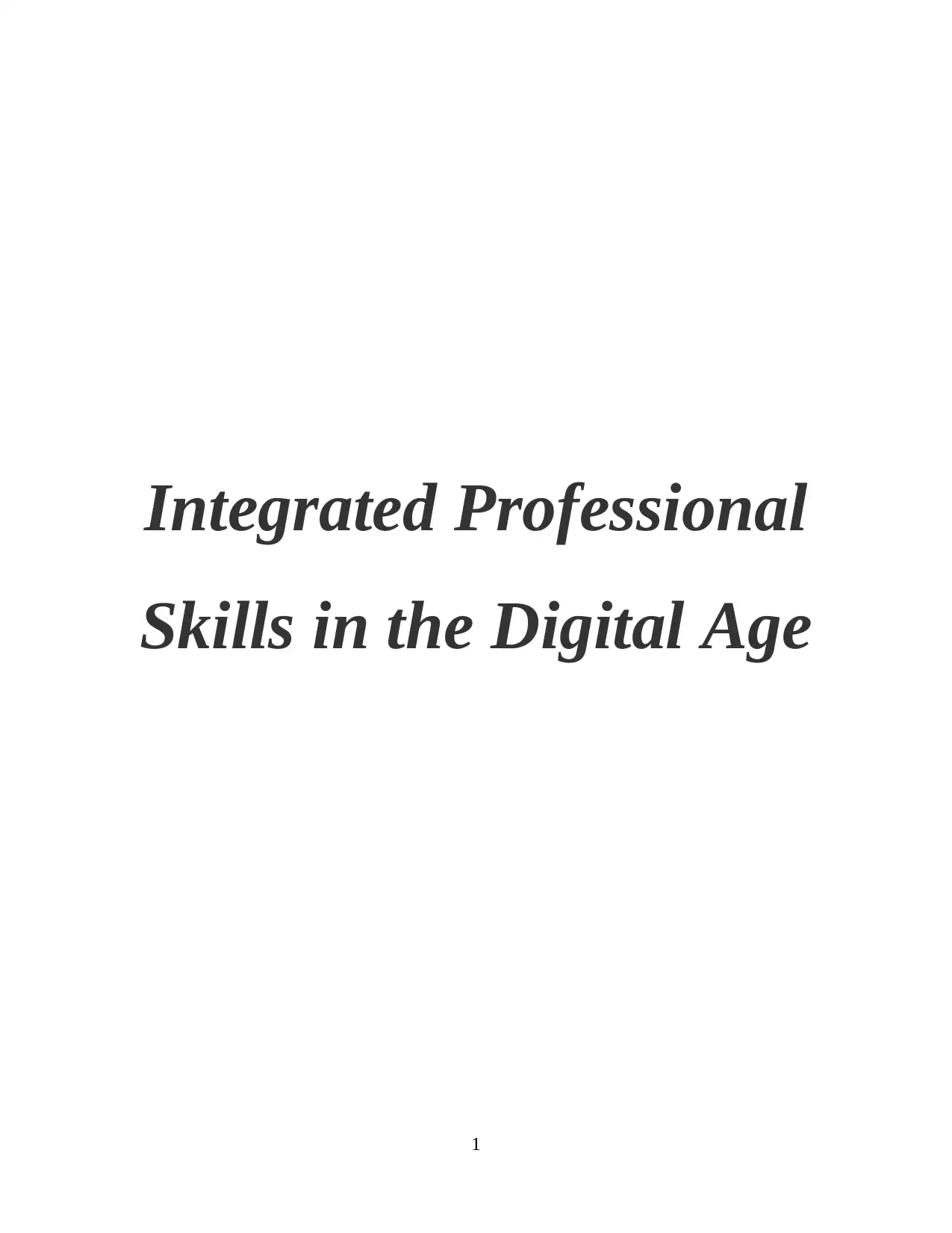
Integrated Professional
Skills in the Digital Age
1
Skills in the Digital Age
1
Paraphrase This Document
Need a fresh take? Get an instant paraphrase of this document with our AI Paraphraser
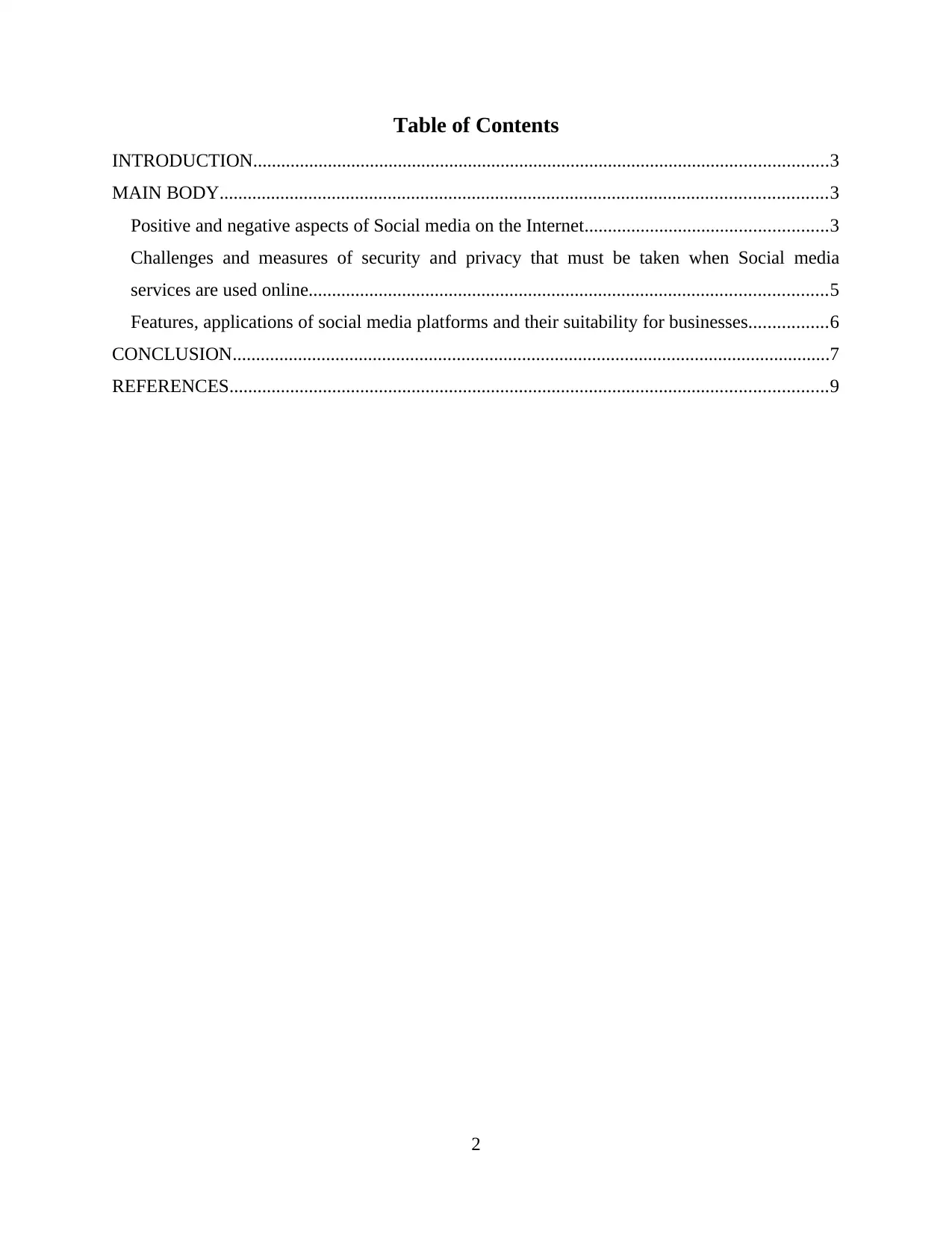
Table of Contents
INTRODUCTION...........................................................................................................................3
MAIN BODY..................................................................................................................................3
Positive and negative aspects of Social media on the Internet....................................................3
Challenges and measures of security and privacy that must be taken when Social media
services are used online...............................................................................................................5
Features, applications of social media platforms and their suitability for businesses.................6
CONCLUSION................................................................................................................................7
REFERENCES................................................................................................................................9
2
INTRODUCTION...........................................................................................................................3
MAIN BODY..................................................................................................................................3
Positive and negative aspects of Social media on the Internet....................................................3
Challenges and measures of security and privacy that must be taken when Social media
services are used online...............................................................................................................5
Features, applications of social media platforms and their suitability for businesses.................6
CONCLUSION................................................................................................................................7
REFERENCES................................................................................................................................9
2
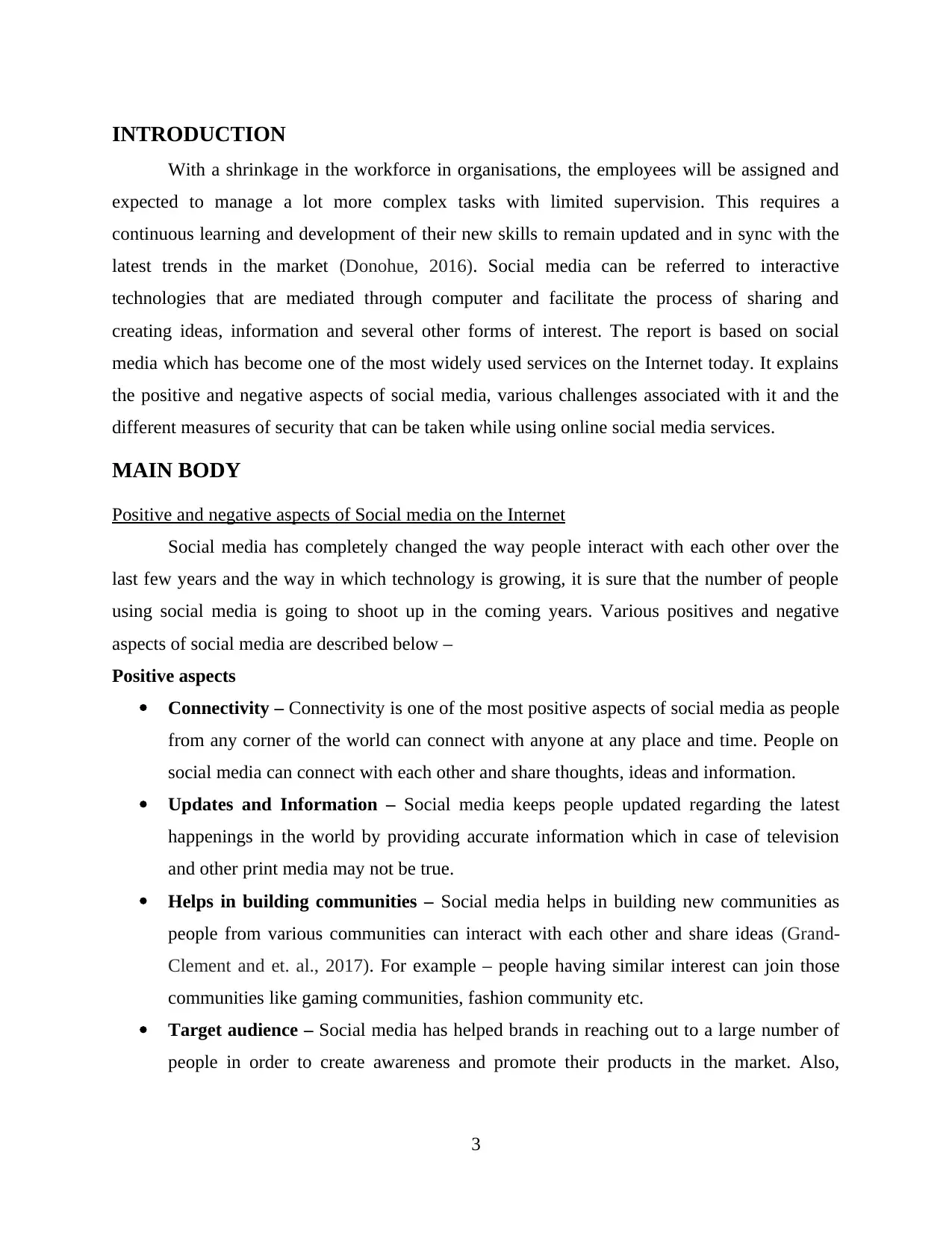
INTRODUCTION
With a shrinkage in the workforce in organisations, the employees will be assigned and
expected to manage a lot more complex tasks with limited supervision. This requires a
continuous learning and development of their new skills to remain updated and in sync with the
latest trends in the market (Donohue, 2016). Social media can be referred to interactive
technologies that are mediated through computer and facilitate the process of sharing and
creating ideas, information and several other forms of interest. The report is based on social
media which has become one of the most widely used services on the Internet today. It explains
the positive and negative aspects of social media, various challenges associated with it and the
different measures of security that can be taken while using online social media services.
MAIN BODY
Positive and negative aspects of Social media on the Internet
Social media has completely changed the way people interact with each other over the
last few years and the way in which technology is growing, it is sure that the number of people
using social media is going to shoot up in the coming years. Various positives and negative
aspects of social media are described below –
Positive aspects
Connectivity – Connectivity is one of the most positive aspects of social media as people
from any corner of the world can connect with anyone at any place and time. People on
social media can connect with each other and share thoughts, ideas and information.
Updates and Information – Social media keeps people updated regarding the latest
happenings in the world by providing accurate information which in case of television
and other print media may not be true.
Helps in building communities – Social media helps in building new communities as
people from various communities can interact with each other and share ideas (Grand-
Clement and et. al., 2017). For example – people having similar interest can join those
communities like gaming communities, fashion community etc.
Target audience – Social media has helped brands in reaching out to a large number of
people in order to create awareness and promote their products in the market. Also,
3
With a shrinkage in the workforce in organisations, the employees will be assigned and
expected to manage a lot more complex tasks with limited supervision. This requires a
continuous learning and development of their new skills to remain updated and in sync with the
latest trends in the market (Donohue, 2016). Social media can be referred to interactive
technologies that are mediated through computer and facilitate the process of sharing and
creating ideas, information and several other forms of interest. The report is based on social
media which has become one of the most widely used services on the Internet today. It explains
the positive and negative aspects of social media, various challenges associated with it and the
different measures of security that can be taken while using online social media services.
MAIN BODY
Positive and negative aspects of Social media on the Internet
Social media has completely changed the way people interact with each other over the
last few years and the way in which technology is growing, it is sure that the number of people
using social media is going to shoot up in the coming years. Various positives and negative
aspects of social media are described below –
Positive aspects
Connectivity – Connectivity is one of the most positive aspects of social media as people
from any corner of the world can connect with anyone at any place and time. People on
social media can connect with each other and share thoughts, ideas and information.
Updates and Information – Social media keeps people updated regarding the latest
happenings in the world by providing accurate information which in case of television
and other print media may not be true.
Helps in building communities – Social media helps in building new communities as
people from various communities can interact with each other and share ideas (Grand-
Clement and et. al., 2017). For example – people having similar interest can join those
communities like gaming communities, fashion community etc.
Target audience – Social media has helped brands in reaching out to a large number of
people in order to create awareness and promote their products in the market. Also,
3
⊘ This is a preview!⊘
Do you want full access?
Subscribe today to unlock all pages.

Trusted by 1+ million students worldwide
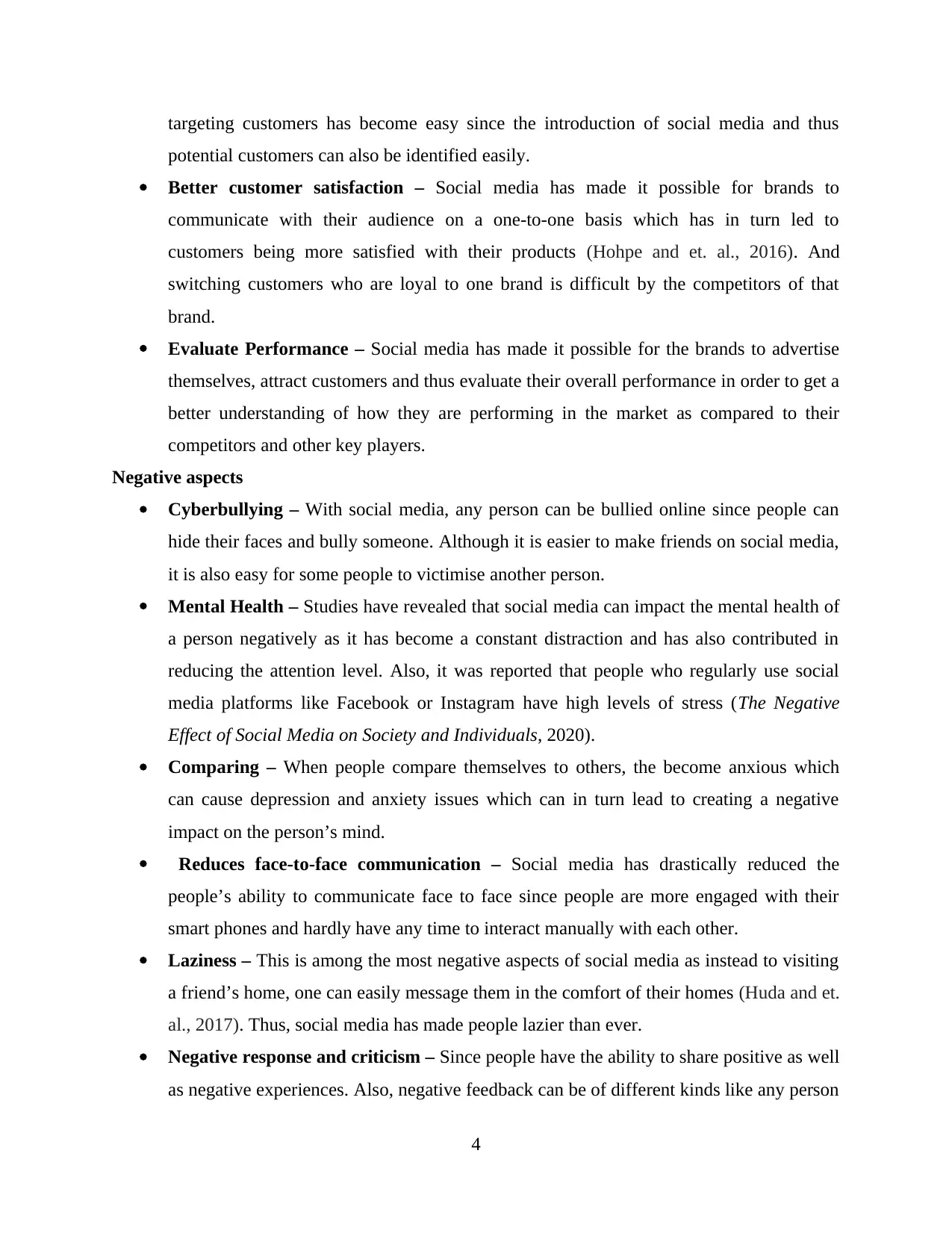
targeting customers has become easy since the introduction of social media and thus
potential customers can also be identified easily.
Better customer satisfaction – Social media has made it possible for brands to
communicate with their audience on a one-to-one basis which has in turn led to
customers being more satisfied with their products (Hohpe and et. al., 2016). And
switching customers who are loyal to one brand is difficult by the competitors of that
brand.
Evaluate Performance – Social media has made it possible for the brands to advertise
themselves, attract customers and thus evaluate their overall performance in order to get a
better understanding of how they are performing in the market as compared to their
competitors and other key players.
Negative aspects
Cyberbullying – With social media, any person can be bullied online since people can
hide their faces and bully someone. Although it is easier to make friends on social media,
it is also easy for some people to victimise another person.
Mental Health – Studies have revealed that social media can impact the mental health of
a person negatively as it has become a constant distraction and has also contributed in
reducing the attention level. Also, it was reported that people who regularly use social
media platforms like Facebook or Instagram have high levels of stress (The Negative
Effect of Social Media on Society and Individuals, 2020).
Comparing – When people compare themselves to others, the become anxious which
can cause depression and anxiety issues which can in turn lead to creating a negative
impact on the person’s mind.
Reduces face-to-face communication – Social media has drastically reduced the
people’s ability to communicate face to face since people are more engaged with their
smart phones and hardly have any time to interact manually with each other.
Laziness – This is among the most negative aspects of social media as instead to visiting
a friend’s home, one can easily message them in the comfort of their homes (Huda and et.
al., 2017). Thus, social media has made people lazier than ever.
Negative response and criticism – Since people have the ability to share positive as well
as negative experiences. Also, negative feedback can be of different kinds like any person
4
potential customers can also be identified easily.
Better customer satisfaction – Social media has made it possible for brands to
communicate with their audience on a one-to-one basis which has in turn led to
customers being more satisfied with their products (Hohpe and et. al., 2016). And
switching customers who are loyal to one brand is difficult by the competitors of that
brand.
Evaluate Performance – Social media has made it possible for the brands to advertise
themselves, attract customers and thus evaluate their overall performance in order to get a
better understanding of how they are performing in the market as compared to their
competitors and other key players.
Negative aspects
Cyberbullying – With social media, any person can be bullied online since people can
hide their faces and bully someone. Although it is easier to make friends on social media,
it is also easy for some people to victimise another person.
Mental Health – Studies have revealed that social media can impact the mental health of
a person negatively as it has become a constant distraction and has also contributed in
reducing the attention level. Also, it was reported that people who regularly use social
media platforms like Facebook or Instagram have high levels of stress (The Negative
Effect of Social Media on Society and Individuals, 2020).
Comparing – When people compare themselves to others, the become anxious which
can cause depression and anxiety issues which can in turn lead to creating a negative
impact on the person’s mind.
Reduces face-to-face communication – Social media has drastically reduced the
people’s ability to communicate face to face since people are more engaged with their
smart phones and hardly have any time to interact manually with each other.
Laziness – This is among the most negative aspects of social media as instead to visiting
a friend’s home, one can easily message them in the comfort of their homes (Huda and et.
al., 2017). Thus, social media has made people lazier than ever.
Negative response and criticism – Since people have the ability to share positive as well
as negative experiences. Also, negative feedback can be of different kinds like any person
4
Paraphrase This Document
Need a fresh take? Get an instant paraphrase of this document with our AI Paraphraser
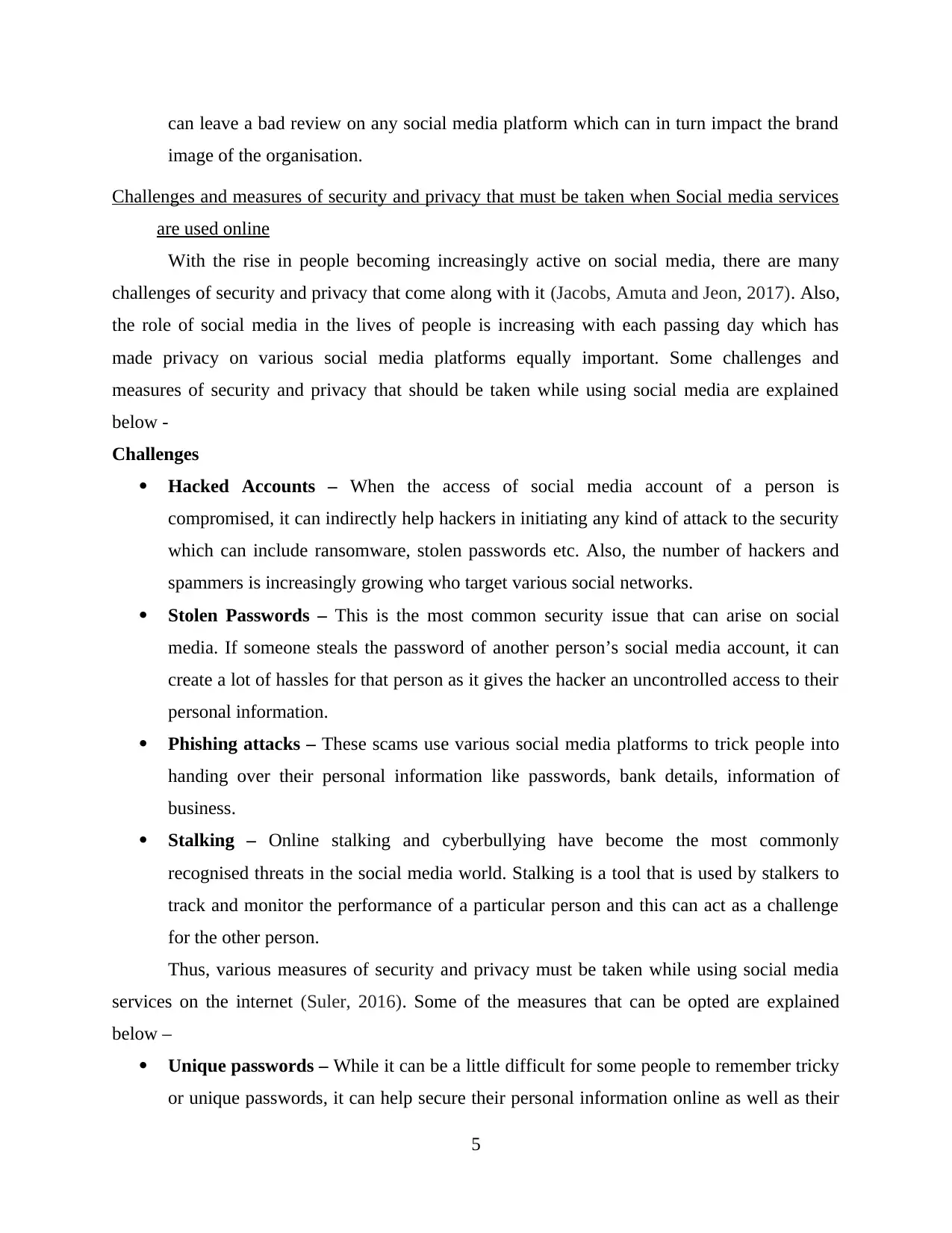
can leave a bad review on any social media platform which can in turn impact the brand
image of the organisation.
Challenges and measures of security and privacy that must be taken when Social media services
are used online
With the rise in people becoming increasingly active on social media, there are many
challenges of security and privacy that come along with it (Jacobs, Amuta and Jeon, 2017). Also,
the role of social media in the lives of people is increasing with each passing day which has
made privacy on various social media platforms equally important. Some challenges and
measures of security and privacy that should be taken while using social media are explained
below -
Challenges
Hacked Accounts – When the access of social media account of a person is
compromised, it can indirectly help hackers in initiating any kind of attack to the security
which can include ransomware, stolen passwords etc. Also, the number of hackers and
spammers is increasingly growing who target various social networks.
Stolen Passwords – This is the most common security issue that can arise on social
media. If someone steals the password of another person’s social media account, it can
create a lot of hassles for that person as it gives the hacker an uncontrolled access to their
personal information.
Phishing attacks – These scams use various social media platforms to trick people into
handing over their personal information like passwords, bank details, information of
business.
Stalking – Online stalking and cyberbullying have become the most commonly
recognised threats in the social media world. Stalking is a tool that is used by stalkers to
track and monitor the performance of a particular person and this can act as a challenge
for the other person.
Thus, various measures of security and privacy must be taken while using social media
services on the internet (Suler, 2016). Some of the measures that can be opted are explained
below –
Unique passwords – While it can be a little difficult for some people to remember tricky
or unique passwords, it can help secure their personal information online as well as their
5
image of the organisation.
Challenges and measures of security and privacy that must be taken when Social media services
are used online
With the rise in people becoming increasingly active on social media, there are many
challenges of security and privacy that come along with it (Jacobs, Amuta and Jeon, 2017). Also,
the role of social media in the lives of people is increasing with each passing day which has
made privacy on various social media platforms equally important. Some challenges and
measures of security and privacy that should be taken while using social media are explained
below -
Challenges
Hacked Accounts – When the access of social media account of a person is
compromised, it can indirectly help hackers in initiating any kind of attack to the security
which can include ransomware, stolen passwords etc. Also, the number of hackers and
spammers is increasingly growing who target various social networks.
Stolen Passwords – This is the most common security issue that can arise on social
media. If someone steals the password of another person’s social media account, it can
create a lot of hassles for that person as it gives the hacker an uncontrolled access to their
personal information.
Phishing attacks – These scams use various social media platforms to trick people into
handing over their personal information like passwords, bank details, information of
business.
Stalking – Online stalking and cyberbullying have become the most commonly
recognised threats in the social media world. Stalking is a tool that is used by stalkers to
track and monitor the performance of a particular person and this can act as a challenge
for the other person.
Thus, various measures of security and privacy must be taken while using social media
services on the internet (Suler, 2016). Some of the measures that can be opted are explained
below –
Unique passwords – While it can be a little difficult for some people to remember tricky
or unique passwords, it can help secure their personal information online as well as their
5
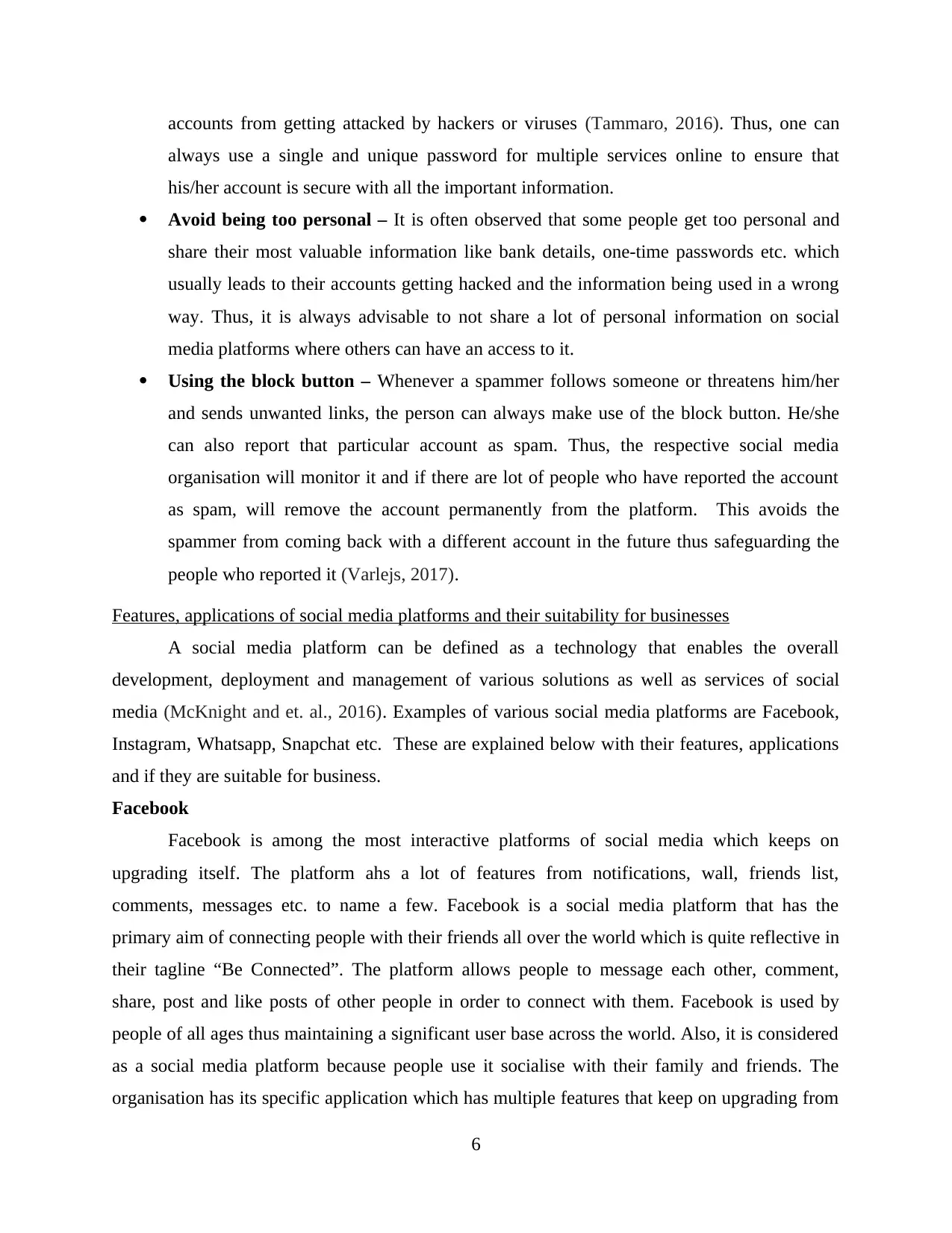
accounts from getting attacked by hackers or viruses (Tammaro, 2016). Thus, one can
always use a single and unique password for multiple services online to ensure that
his/her account is secure with all the important information.
Avoid being too personal – It is often observed that some people get too personal and
share their most valuable information like bank details, one-time passwords etc. which
usually leads to their accounts getting hacked and the information being used in a wrong
way. Thus, it is always advisable to not share a lot of personal information on social
media platforms where others can have an access to it.
Using the block button – Whenever a spammer follows someone or threatens him/her
and sends unwanted links, the person can always make use of the block button. He/she
can also report that particular account as spam. Thus, the respective social media
organisation will monitor it and if there are lot of people who have reported the account
as spam, will remove the account permanently from the platform. This avoids the
spammer from coming back with a different account in the future thus safeguarding the
people who reported it (Varlejs, 2017).
Features, applications of social media platforms and their suitability for businesses
A social media platform can be defined as a technology that enables the overall
development, deployment and management of various solutions as well as services of social
media (McKnight and et. al., 2016). Examples of various social media platforms are Facebook,
Instagram, Whatsapp, Snapchat etc. These are explained below with their features, applications
and if they are suitable for business.
Facebook
Facebook is among the most interactive platforms of social media which keeps on
upgrading itself. The platform ahs a lot of features from notifications, wall, friends list,
comments, messages etc. to name a few. Facebook is a social media platform that has the
primary aim of connecting people with their friends all over the world which is quite reflective in
their tagline “Be Connected”. The platform allows people to message each other, comment,
share, post and like posts of other people in order to connect with them. Facebook is used by
people of all ages thus maintaining a significant user base across the world. Also, it is considered
as a social media platform because people use it socialise with their family and friends. The
organisation has its specific application which has multiple features that keep on upgrading from
6
always use a single and unique password for multiple services online to ensure that
his/her account is secure with all the important information.
Avoid being too personal – It is often observed that some people get too personal and
share their most valuable information like bank details, one-time passwords etc. which
usually leads to their accounts getting hacked and the information being used in a wrong
way. Thus, it is always advisable to not share a lot of personal information on social
media platforms where others can have an access to it.
Using the block button – Whenever a spammer follows someone or threatens him/her
and sends unwanted links, the person can always make use of the block button. He/she
can also report that particular account as spam. Thus, the respective social media
organisation will monitor it and if there are lot of people who have reported the account
as spam, will remove the account permanently from the platform. This avoids the
spammer from coming back with a different account in the future thus safeguarding the
people who reported it (Varlejs, 2017).
Features, applications of social media platforms and their suitability for businesses
A social media platform can be defined as a technology that enables the overall
development, deployment and management of various solutions as well as services of social
media (McKnight and et. al., 2016). Examples of various social media platforms are Facebook,
Instagram, Whatsapp, Snapchat etc. These are explained below with their features, applications
and if they are suitable for business.
Facebook is among the most interactive platforms of social media which keeps on
upgrading itself. The platform ahs a lot of features from notifications, wall, friends list,
comments, messages etc. to name a few. Facebook is a social media platform that has the
primary aim of connecting people with their friends all over the world which is quite reflective in
their tagline “Be Connected”. The platform allows people to message each other, comment,
share, post and like posts of other people in order to connect with them. Facebook is used by
people of all ages thus maintaining a significant user base across the world. Also, it is considered
as a social media platform because people use it socialise with their family and friends. The
organisation has its specific application which has multiple features that keep on upgrading from
6
⊘ This is a preview!⊘
Do you want full access?
Subscribe today to unlock all pages.

Trusted by 1+ million students worldwide
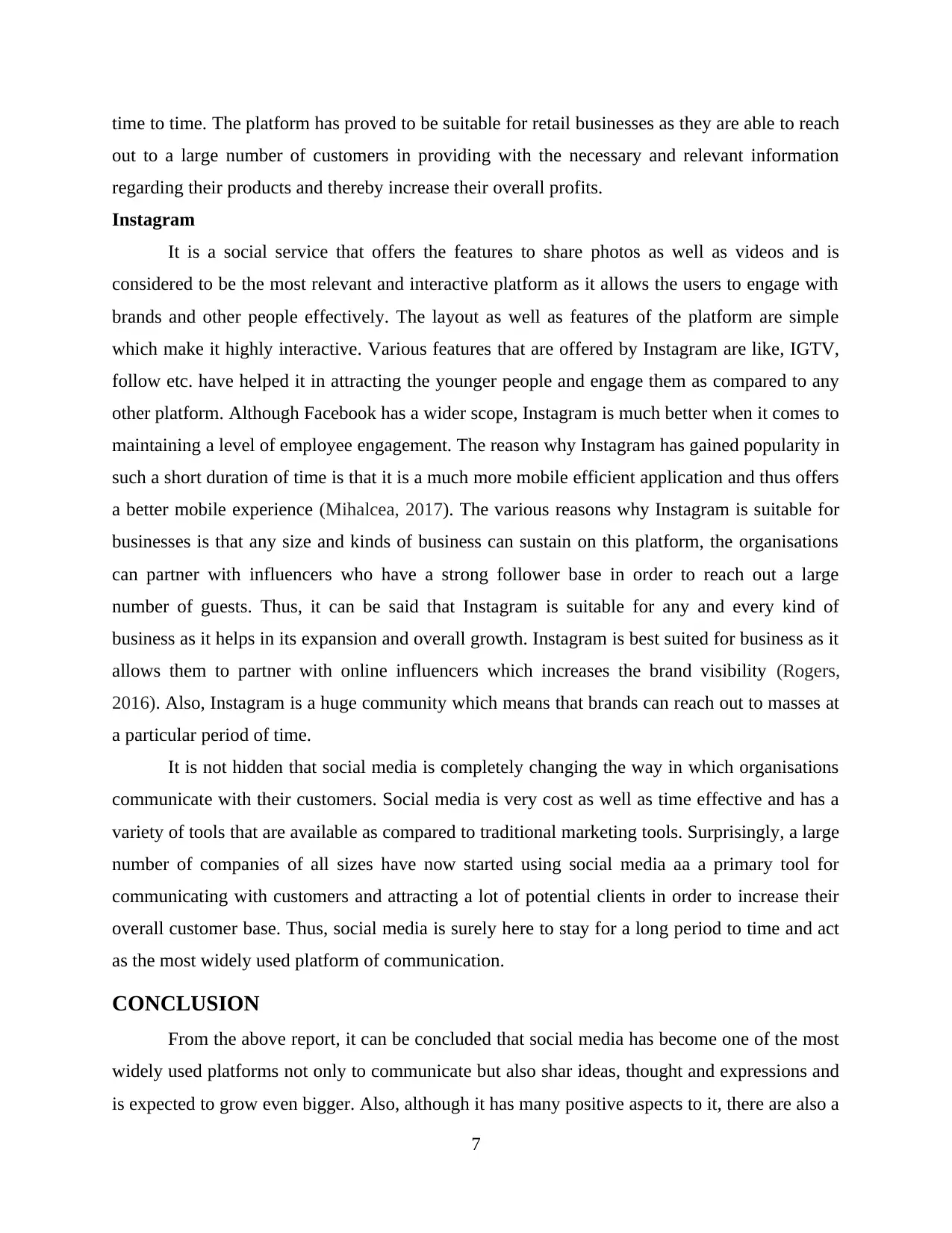
time to time. The platform has proved to be suitable for retail businesses as they are able to reach
out to a large number of customers in providing with the necessary and relevant information
regarding their products and thereby increase their overall profits.
Instagram
It is a social service that offers the features to share photos as well as videos and is
considered to be the most relevant and interactive platform as it allows the users to engage with
brands and other people effectively. The layout as well as features of the platform are simple
which make it highly interactive. Various features that are offered by Instagram are like, IGTV,
follow etc. have helped it in attracting the younger people and engage them as compared to any
other platform. Although Facebook has a wider scope, Instagram is much better when it comes to
maintaining a level of employee engagement. The reason why Instagram has gained popularity in
such a short duration of time is that it is a much more mobile efficient application and thus offers
a better mobile experience (Mihalcea, 2017). The various reasons why Instagram is suitable for
businesses is that any size and kinds of business can sustain on this platform, the organisations
can partner with influencers who have a strong follower base in order to reach out a large
number of guests. Thus, it can be said that Instagram is suitable for any and every kind of
business as it helps in its expansion and overall growth. Instagram is best suited for business as it
allows them to partner with online influencers which increases the brand visibility (Rogers,
2016). Also, Instagram is a huge community which means that brands can reach out to masses at
a particular period of time.
It is not hidden that social media is completely changing the way in which organisations
communicate with their customers. Social media is very cost as well as time effective and has a
variety of tools that are available as compared to traditional marketing tools. Surprisingly, a large
number of companies of all sizes have now started using social media aa a primary tool for
communicating with customers and attracting a lot of potential clients in order to increase their
overall customer base. Thus, social media is surely here to stay for a long period to time and act
as the most widely used platform of communication.
CONCLUSION
From the above report, it can be concluded that social media has become one of the most
widely used platforms not only to communicate but also shar ideas, thought and expressions and
is expected to grow even bigger. Also, although it has many positive aspects to it, there are also a
7
out to a large number of customers in providing with the necessary and relevant information
regarding their products and thereby increase their overall profits.
It is a social service that offers the features to share photos as well as videos and is
considered to be the most relevant and interactive platform as it allows the users to engage with
brands and other people effectively. The layout as well as features of the platform are simple
which make it highly interactive. Various features that are offered by Instagram are like, IGTV,
follow etc. have helped it in attracting the younger people and engage them as compared to any
other platform. Although Facebook has a wider scope, Instagram is much better when it comes to
maintaining a level of employee engagement. The reason why Instagram has gained popularity in
such a short duration of time is that it is a much more mobile efficient application and thus offers
a better mobile experience (Mihalcea, 2017). The various reasons why Instagram is suitable for
businesses is that any size and kinds of business can sustain on this platform, the organisations
can partner with influencers who have a strong follower base in order to reach out a large
number of guests. Thus, it can be said that Instagram is suitable for any and every kind of
business as it helps in its expansion and overall growth. Instagram is best suited for business as it
allows them to partner with online influencers which increases the brand visibility (Rogers,
2016). Also, Instagram is a huge community which means that brands can reach out to masses at
a particular period of time.
It is not hidden that social media is completely changing the way in which organisations
communicate with their customers. Social media is very cost as well as time effective and has a
variety of tools that are available as compared to traditional marketing tools. Surprisingly, a large
number of companies of all sizes have now started using social media aa a primary tool for
communicating with customers and attracting a lot of potential clients in order to increase their
overall customer base. Thus, social media is surely here to stay for a long period to time and act
as the most widely used platform of communication.
CONCLUSION
From the above report, it can be concluded that social media has become one of the most
widely used platforms not only to communicate but also shar ideas, thought and expressions and
is expected to grow even bigger. Also, although it has many positive aspects to it, there are also a
7
Paraphrase This Document
Need a fresh take? Get an instant paraphrase of this document with our AI Paraphraser
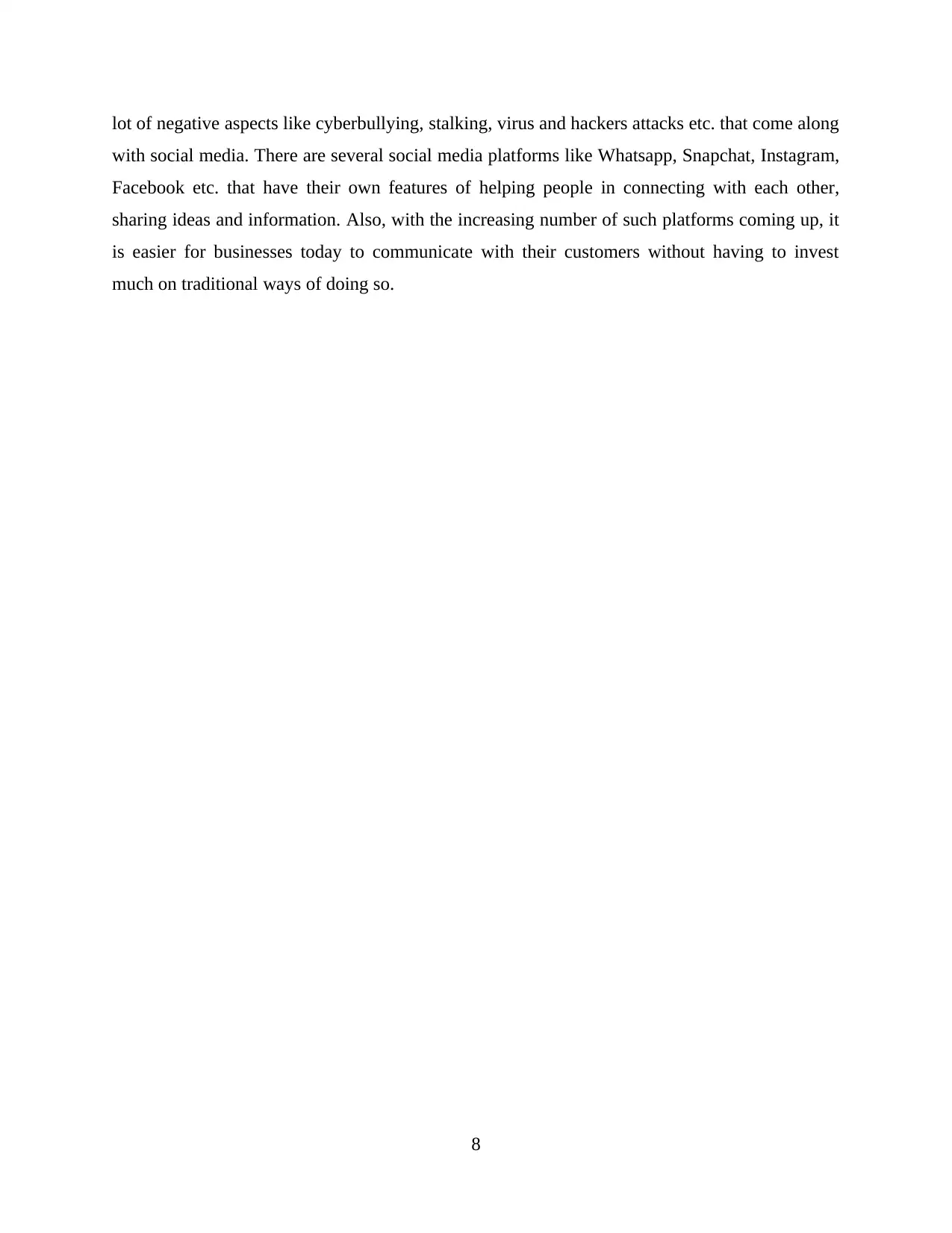
lot of negative aspects like cyberbullying, stalking, virus and hackers attacks etc. that come along
with social media. There are several social media platforms like Whatsapp, Snapchat, Instagram,
Facebook etc. that have their own features of helping people in connecting with each other,
sharing ideas and information. Also, with the increasing number of such platforms coming up, it
is easier for businesses today to communicate with their customers without having to invest
much on traditional ways of doing so.
8
with social media. There are several social media platforms like Whatsapp, Snapchat, Instagram,
Facebook etc. that have their own features of helping people in connecting with each other,
sharing ideas and information. Also, with the increasing number of such platforms coming up, it
is easier for businesses today to communicate with their customers without having to invest
much on traditional ways of doing so.
8
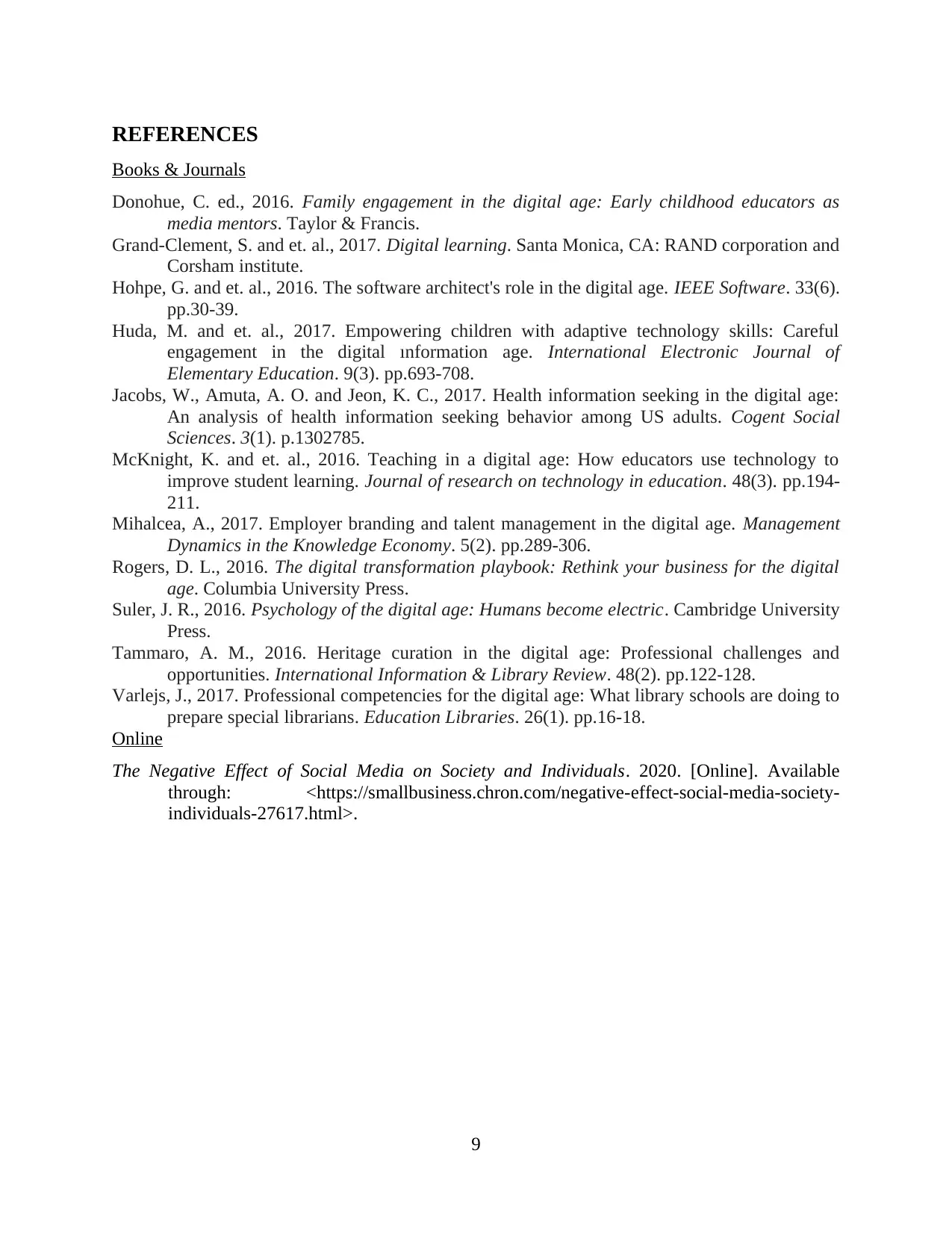
REFERENCES
Books & Journals
Donohue, C. ed., 2016. Family engagement in the digital age: Early childhood educators as
media mentors. Taylor & Francis.
Grand-Clement, S. and et. al., 2017. Digital learning. Santa Monica, CA: RAND corporation and
Corsham institute.
Hohpe, G. and et. al., 2016. The software architect's role in the digital age. IEEE Software. 33(6).
pp.30-39.
Huda, M. and et. al., 2017. Empowering children with adaptive technology skills: Careful
engagement in the digital ınformation age. International Electronic Journal of
Elementary Education. 9(3). pp.693-708.
Jacobs, W., Amuta, A. O. and Jeon, K. C., 2017. Health information seeking in the digital age:
An analysis of health information seeking behavior among US adults. Cogent Social
Sciences. 3(1). p.1302785.
McKnight, K. and et. al., 2016. Teaching in a digital age: How educators use technology to
improve student learning. Journal of research on technology in education. 48(3). pp.194-
211.
Mihalcea, A., 2017. Employer branding and talent management in the digital age. Management
Dynamics in the Knowledge Economy. 5(2). pp.289-306.
Rogers, D. L., 2016. The digital transformation playbook: Rethink your business for the digital
age. Columbia University Press.
Suler, J. R., 2016. Psychology of the digital age: Humans become electric. Cambridge University
Press.
Tammaro, A. M., 2016. Heritage curation in the digital age: Professional challenges and
opportunities. International Information & Library Review. 48(2). pp.122-128.
Varlejs, J., 2017. Professional competencies for the digital age: What library schools are doing to
prepare special librarians. Education Libraries. 26(1). pp.16-18.
Online
The Negative Effect of Social Media on Society and Individuals. 2020. [Online]. Available
through: <https://smallbusiness.chron.com/negative-effect-social-media-society-
individuals-27617.html>.
9
Books & Journals
Donohue, C. ed., 2016. Family engagement in the digital age: Early childhood educators as
media mentors. Taylor & Francis.
Grand-Clement, S. and et. al., 2017. Digital learning. Santa Monica, CA: RAND corporation and
Corsham institute.
Hohpe, G. and et. al., 2016. The software architect's role in the digital age. IEEE Software. 33(6).
pp.30-39.
Huda, M. and et. al., 2017. Empowering children with adaptive technology skills: Careful
engagement in the digital ınformation age. International Electronic Journal of
Elementary Education. 9(3). pp.693-708.
Jacobs, W., Amuta, A. O. and Jeon, K. C., 2017. Health information seeking in the digital age:
An analysis of health information seeking behavior among US adults. Cogent Social
Sciences. 3(1). p.1302785.
McKnight, K. and et. al., 2016. Teaching in a digital age: How educators use technology to
improve student learning. Journal of research on technology in education. 48(3). pp.194-
211.
Mihalcea, A., 2017. Employer branding and talent management in the digital age. Management
Dynamics in the Knowledge Economy. 5(2). pp.289-306.
Rogers, D. L., 2016. The digital transformation playbook: Rethink your business for the digital
age. Columbia University Press.
Suler, J. R., 2016. Psychology of the digital age: Humans become electric. Cambridge University
Press.
Tammaro, A. M., 2016. Heritage curation in the digital age: Professional challenges and
opportunities. International Information & Library Review. 48(2). pp.122-128.
Varlejs, J., 2017. Professional competencies for the digital age: What library schools are doing to
prepare special librarians. Education Libraries. 26(1). pp.16-18.
Online
The Negative Effect of Social Media on Society and Individuals. 2020. [Online]. Available
through: <https://smallbusiness.chron.com/negative-effect-social-media-society-
individuals-27617.html>.
9
⊘ This is a preview!⊘
Do you want full access?
Subscribe today to unlock all pages.

Trusted by 1+ million students worldwide
1 out of 9
Related Documents
Your All-in-One AI-Powered Toolkit for Academic Success.
+13062052269
info@desklib.com
Available 24*7 on WhatsApp / Email
![[object Object]](/_next/static/media/star-bottom.7253800d.svg)
Unlock your academic potential
Copyright © 2020–2025 A2Z Services. All Rights Reserved. Developed and managed by ZUCOL.





